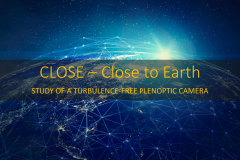
Studying a new "small" spacecraft capable of hosting a RAM-EP propulsion system and capable of operating at VLEO
The main directions to which the space industry evolves are the increasing miniaturization of satellites and the increasing accuracy of measured data.
A valid method in almost all Earth Observation applications to improve data accuracy is to lower the altitude at which this is detected. There is of course a limit, due to the fact that atmospheric drag forces more and more the use engines to keep the satellite in orbit. This implies a high propellant consumption and, ultimately, imposes a strict limit on the operating life of the spacecraft. In recent years, a concept of propulsion system (RAM-EP) has been developed that can use the gases present in the atmosphere as a propellant and therefore not be limited by the quantity loaded into the tank. This propulsion system would greatly extend the operating life of a very low orbital spacecraft (in this proposal we define VLEO, Very Low Earth Orbit, orbits below 250 km).
Goals and outcomes
The project intends to study and develop this concept to achieve a prototype RAM-EP propulsion system, the main components of which are the atmospheric gas intake and the Hall-Effect Thruster that uses them as a propellant.
The project also aims at studying a new "small" spacecraft (below 500 kg of total mass) capable of hosting a RAM-EP propulsion system and capable of operating at VLEO. Specifically, the range to be studied in the project is between 160 and 250 km, an area which is unexplored for spacecraft, except for the GOCE scientific mission (which, however, only for a short period of time at the end of its operating life flew between 225 and 250km). Just as for GOCE (and to a greater extent), the spacecraft will have to be thought out ex-novo, having to study aerodynamic issues to deal with drag.
Finally, the project will study some of the applications and services that can be realized with satellites and constellations by operating at an altitude so far never used for Earth Observation. We will investigate possible payloads that can be hosted by the spacecraft.
Planetek in particular deals with the application scenarios that a VLEO satellite can meet in an innovative way, of its enabling technologies such as attitude estimation and contributes to the design of the innovative Quantum Plenoptic Camera proposed by the University of Bari.
Partners: Distretto Tecnologico Aerospaziale, ENAV, Telespazio, Università di Bari, Vitrociset, Aeroporti di Puglia, Università Kore di Enna, Istituto nazionale di fisica nucleare, Leonardo, Centro nazionale delle ricerche, ENEA, Planetek, Enginsoft, Politecnico di Bari.
Project cofunded by European Union – SIE, PON Ricerca e Innovazione 2014-2020 (www.ponricerca.gov.it)

Project information
Client information:
MIUR
Application fields:

